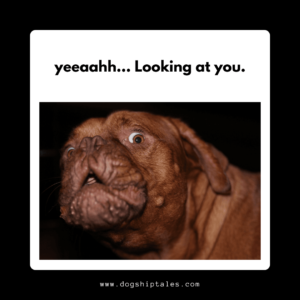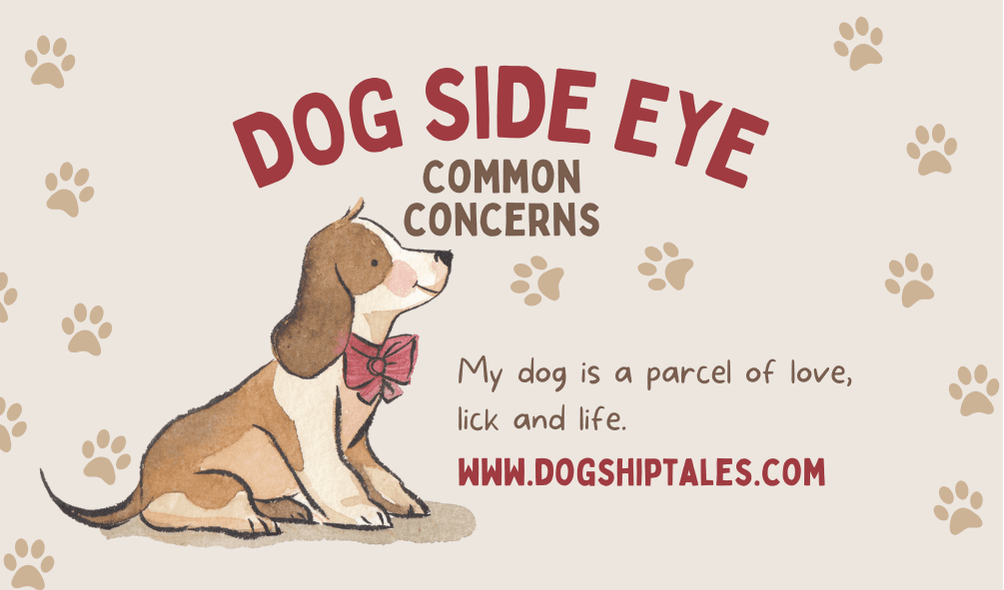There are coming a number of questions regarding dog side eyeing habit and people are very much believing on myths circulating around. Let me ease your concerns here,
1. What does it mean when a dog gives you the side eye?
When a dog gives you the side eye, also known as “whale eye,” it often signals discomfort, stress, or vigilance. This canine body language is usually a way of communicating unease in their environment, such as during resource guarding, sudden movements, or unfamiliar situations.
2. Is a dog’s side eye a sign of fear or aggression?
Side eye in dogs isn’t always a direct sign of fear or aggression, but it can be a precursor if accompanied by dog stress signals like growling, lip licking, or a stiff posture. Recognizing this in dog communication helps pet parents manage the situation.
3. Can side eye in dogs indicate curiosity?
Yes, in playful or relaxed situations, side eye may indicate curiosity or focus. Dogs often use it when observing their surroundings or assessing a new object or person. Pair it with other cues like a wagging tail or relaxed ears to understand the intent.
4. How can you tell if a dog’s side eye means they are uncomfortable?
Look for clusters of stress signals, including avoidance behaviors, tense body posture, pinned-back ears, or lip licking. If these dog anxiety behaviors are present, the side eye likely reflects unease.
5. Why do some dog breeds show the side eye more often?
Flat-faced breeds like Bulldogs and Pugs are more prone to showing side eye due to their facial anatomy, which naturally exposes more of the sclera (whites of the eyes). Their body language must be interpreted within this context.
6. Is side eye the same as “whale eye” in dogs?
Yes, side eye is commonly referred to as “whale eye” in dog behavior analysis. This term is used when the whites of the eyes are highly visible, often as a canine side glance.
7. Can side eye in dogs be playful or mischievous?
Absolutely. When paired with relaxed ears, a wagging tail, or a playful stance, the side eye might indicate mischievous intent, especially during playtime or games like fetch.
8. Are there medical reasons for a dog giving the side eye?
Yes, conditions like eye infections, strabismus (eye misalignment), or neurological issues can cause a dog to exhibit frequent side eye. If this behavior is new or persistent, consult a veterinarian.
9. Does the side eye in dogs mean they are annoyed?
Sometimes, yes. Dogs may use side eye to signal irritation, especially if they want space or dislike certain actions (e.g., being touched in sensitive areas). Understanding this as part of dog communication is key to respectful interactions.
10. What is the difference between side eye and direct eye contact in dogs?
Direct eye contact often signals confidence, curiosity, or even a challenge, depending on the dog’s body language. Side eye typically indicates discomfort, avoidance, or a cautious evaluation of their environment.
11. How do environmental triggers cause dogs to give the side eye?
Triggers like loud noises, unfamiliar people, or sudden movements often cause a dog to exhibit side eye. These are common stressors in dog anxiety behaviors.
12. Should you be concerned if your dog frequently gives the side eye?
Frequent side eye may indicate chronic stress, anxiety, or an underlying health issue. Observing their body language and environment helps identify potential causes.
13. Can stress or anxiety cause side eye in dogs?
Yes, stress and anxiety are major factors behind whale eye in dogs. Changes in routine, unfamiliar environments, or interactions with other pets can prompt this behavior.
14. How do you respond to a dog showing side eye?
Avoid confrontation, provide space, and create a calming environment. Positive reinforcement and gradual desensitization to stressors help reduce dog stress signals. I have discussed it in detail here: What really Dog Side Eye Indicates? Reality VS Myth
15. What does it mean if a dog gives a side eye during playtime?
A playful side eye during games often reflects excitement or anticipation. Dogs might use it as part of their social play signals, especially in friendly interactions.
16. Is side eye behavior learned or instinctive in dogs?
Side eye is instinctive and rooted in canine evolutionary behaviors. However, experiences and training influence how and when dogs display this body language.
17. How do you differentiate a side eye from a medical condition like strabismus?
Side eye is typically situational and tied to emotions or environmental triggers, while strabismus is a consistent physical condition involving eye alignment. Consult a vet if unsure.
18. Can training reduce anxiety-related side eye in dogs?
Yes, training techniques such as counter-conditioning and desensitization can reduce anxiety-related behaviors, including whale eye, by addressing the root causes of stress.
19. Why do Bulldogs and other flat-faced breeds seem to give more side eye?
Their facial structure naturally exposes more of the whites of their eyes, making side eye more noticeable even in non-stressful contexts.

20. How can you interpret a dog’s side eye along with other body language cues?
Combining cues like ear position, tail movement, and posture helps decode side eye. For example, a tense body with pinned ears suggests stress, while relaxed posture with side eye is likely playful.

